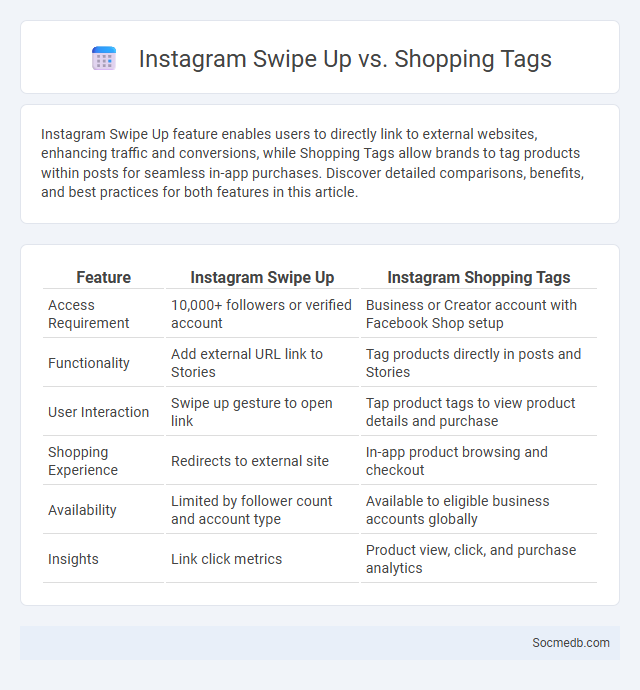
Photo illustration: Instagram Swipe Up vs Shopping Tags
Instagram Swipe Up feature enables users to directly link to external websites, enhancing traffic and conversions, while Shopping Tags allow brands to tag products within posts for seamless in-app purchases. Discover detailed comparisons, benefits, and best practices for both features in this article.
Table of Comparison
| Feature | Instagram Swipe Up | Instagram Shopping Tags |
|---|---|---|
| Access Requirement | 10,000+ followers or verified account | Business or Creator account with Facebook Shop setup |
| Functionality | Add external URL link to Stories | Tag products directly in posts and Stories |
| User Interaction | Swipe up gesture to open link | Tap product tags to view product details and purchase |
| Shopping Experience | Redirects to external site | In-app product browsing and checkout |
| Availability | Limited by follower count and account type | Available to eligible business accounts globally |
| Insights | Link click metrics | Product view, click, and purchase analytics |
Introduction to Instagram Swipe Up and Shopping Tags
Instagram Swipe Up allows your audience to access external links directly from Stories, boosting traffic and engagement. Shopping Tags enable you to showcase products within posts and stories, providing a seamless path from discovery to purchase. Leveraging these tools can enhance your brand's visibility and drive sales effectively.
How Instagram Swipe Up Works
Instagram Swipe Up allows users with over 10,000 followers or verified accounts to add a link to their Stories, enabling direct traffic to external websites. By swiping up on the Story, your audience can instantly access product pages, articles, or other online content, increasing engagement and conversion rates. This feature is essential for businesses and influencers aiming to drive targeted traffic without interrupting the user experience.
Features of Instagram Shopping Tags
Instagram Shopping Tags allow businesses to showcase products directly within posts, making it easier for customers to discover and purchase items seamlessly. These tags provide detailed product information, including price and descriptions, enhancing user engagement and driving sales. By integrating shopping tags into your content, you can create a smooth shopping experience that connects your audience with your products effectively.
Swipe Up vs Shopping Tags: Key Differences
Swipe Up allows Instagram users with over 10,000 followers to link directly to external websites through Stories, increasing traffic and conversions. Shopping Tags enable brands to tag products in posts and Stories, offering a seamless in-app shopping experience by directing users to product pages without leaving Instagram. Both features drive engagement but differ in usability: Swipe Up is link-based and limited by follower count, while Shopping Tags integrate e-commerce directly within the platform.
User Experience: Which Drives More Engagement?
User experience on social media platforms significantly drives engagement by prioritizing intuitive navigation, personalized content, and fast-loading features. Algorithms that tailor feeds based on user behavior enhance relevance, encouraging longer sessions and more interactions such as likes, comments, and shares. Your engagement grows when platforms seamlessly integrate multimedia formats and interactive tools that create immersive experiences.
Eligibility Requirements for Swipe Up and Shopping Tags
To access the Swipe Up feature on Instagram Stories, accounts must have at least 10,000 followers or be verified, ensuring higher engagement and authenticity. For Shopping Tags, businesses need to comply with Instagram's commerce policies, have an eligible product catalog linked via Facebook Shop, and operate in supported markets. These requirements optimize user interaction by enabling seamless product discovery and direct purchasing within the platform.
Conversion Rates: Swipe Up vs Shopping Tags
Analyzing conversion rates, Shopping Tags generally outperform Swipe Up links by directly linking products within posts, facilitating smoother purchasing experiences for Your audience. Shopping Tags reduce barriers by allowing users to tap on specific items without leaving the social media platform, increasing the likelihood of impulse buys and boosting overall sales. Brands leveraging Shopping Tags see higher engagement-to-purchase ratios than those relying solely on Swipe Up features.
Best Practices for Using Swipe Up Links
Maximize engagement on social media by strategically placing swipe up links in your Stories to drive traffic and conversions. Use clear calls-to-action that encourage Your audience to swipe up for exclusive content, promotions, or sign-ups, ensuring the link destination is mobile-optimized for seamless user experience. Track performance metrics such as click-through rates and conversions regularly to refine your swipe up link strategy for optimal results.
Optimizing Instagram Shopping Tags for Sales
Optimizing Instagram Shopping Tags involves strategically tagging products in posts and stories to enhance visibility and drive direct sales. Utilize high-quality images, relevant keywords, and clear product descriptions within tags to improve discoverability and user engagement. Regularly analyze performance metrics to refine tag placement and maximize conversion rates on the platform.
Choosing the Right Feature for Your Brand’s Strategy
Selecting the right social media feature for your brand's strategy involves analyzing your target audience's behavior and preferences across platforms like Instagram Reels, Facebook Stories, or LinkedIn Articles. Each feature offers unique engagement formats, such as short-form videos for increased visibility or long-form content for thought leadership, which can amplify your brand's reach and interaction. Make data-driven decisions that align with your content goals to maximize impact and foster authentic connections with your followers.
 socmedb.com
socmedb.com